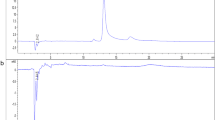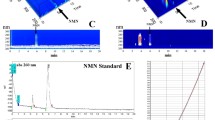Abstract
Nuclease P1 (NP1) can hydrolyze nucleic acids into four 5′-mononucleotides, which are widely used in the pharmaceutical and food industries. In this paper, an aqueous two-phase system (ATPS) was developed to purify NP1 from Penicillium citrinum. Polyethylene glycol (PEG) and nucleotides salts were studied to form ATPSs, among which PEG3000/disodium guanosine monophosphate (GMPNa2) was researched, including the phase composition and pH. Using 14% (w/w) PEG3000 and 20% (w/w) GMPNa2 ATPS at pH 5.0, the best recovery and purification factor, 82.4% and 3.59, were obtained. The recovery of NP1 was 98.3% by the separation of ultrafiltration from the PEG-rich phase. The recycling use of GMPNa2 was also studied, and 95.1% of GMPNa2 in the salt-rich phase was obtained with the addition of ethanol as the solvent. These results showed that the ATPS was effective for purification of NP1.







Similar content being viewed by others
Data Availability
Not applicable.
Code Availability
Not applicable.
References
Maekawa, K., Tsunasawa, S., Dibo, G., & Sakiyama, F. (1991). Primary structure of nuclease P1 from penicillium citrinum. European Journal of Biochemistry, 200, 651–661.
Tabata, N., Kazama, H., Ohgi, K., & Irie, M. (1991). Primary structure of nuclease (nuclease PA3) from penicillium sp. Agricultural and Biological Chemistry, 55, 461–469.
Fujimoto, M., Kuninaka, A., & Yoshino, H. (1974). Purification of a nuclease from Penicillium citrinum. Agricultural and Biological Chemistry, 38, 777–783.
Fujimoto, M., Kuninaka, A., & Yoshino, H. (1974). Identity of phosphodiesterase and phosphomonoesterase activities with nuclease P1 (a nuclease from Penicillium citrinum). Agricultural and Biological Chemistry, 38, 785–790.
Fujimoto, M., Kuninaka, A., & Yoshino, H. (1974). Substrate specificity of nuclease P1. Agricultural and Biological Chemistry, 38, 1555–1561.
Fujimoto, M., Kuninaka, A., & Yoshino, H. (1975). Some physical and chemical properties of nuclease P1. Agricultural and Biological Chemistry, 39, 1991–1997.
Lahm, A., Volbeda, A., & Suck, D. (1990). Crystallisation and preliminary crystallographic analysis of P1 nuclease from Penicillium citrinum. Journal of Molecular Biology, 215, 207–210.
Kuninaka, A. (2008). Nucleotides and related compounds. In Biotechnology (pp. 561–612). Wiley-VCH.
Gerald, R., & Tilak, W. (1991). Yeast derived products. In Yeast Technology (pp. 369–412). AVI.
Ying, G. Q., Shi, L. E., Yi, Y., Tang, Z. X., & Chen, J. S. (2006). Production, purification and characterization of nuclease p1 from Penicillium citrinum. Process Biochemistry, 41, 1276–1281.
Vaidya, B. K., Suthar, H. K., Kasture, S., & Nene, S. (2006). Purification of potato polyphenol oxidase (PPO) by partitioning in aqueous two-phase system. Biochemical Engineering Journal, 28, 161–166.
Fakhari, M. A., Rahimpour, F., & Taran, M. (2017). Response surface methodology optimization of partitioning of xylanase form Aspergillus niger by metal affinity polymer-salt aqueous two-phase systems. Journal of Chromatography, B: Analytical Technologies in the Biomedical and Life Sciences, 1063, 1–10.
Chen, X., Wang, J., & Jiao, F. (2015). Efficient enantioseparation of phenylsuccinic acid enantiomers by aqueous two-phase system-based biphasic recognition chiral extraction: Phase behaviors and distribution experiments. Process Biochemistry, 50, 1468–1478.
Iqbal, M., Tao, Y., Xie, S., Zhu, Y., Chen, D., Wang, X., Huang, L., Peng, D., Sattar, A., Shabbir, M. A., Hussain, H. I., Ahmed, S., & Yuan, Z. (2016). Aqueous two-phase system (ATPS): An overview and advances in its applications. Biological Procedures Online, 18, 18.
Hatti-Kaul, R. (2001). Aqueous two-phase systems. Molecular Biotechnology, 19, 269–277.
Li, M., Kim, J. W., & Peeples, T. L. (2002). Amylase partitioning and extractive bioconversion of starch using thermoseparating aqueous two-phase systems. Journal of Biotechnology, 93, 15–26.
Cao, X. J., Wu, X. Y., Fonseca, L. J. P., Cabral, J. M. S., & Marcos, J. C. (2004). Production of 6-aminopenicillanic acid in aqueous two-phase systems by recombinant Escherichia coli with intracellular penicillin acylase. Biotechnology Letters, 26, 97–101.
Cizova, A., Korcova, J., Farkas, P., & Bystricky, S. (2017). Efficient separation of mannan-protein mixtures by ionic liquid aqueous two-phase system, comparison with lectin affinity purification. International Journal of Biological Macromolecules, 98, 314–318.
Ufuk, G. (2000). Partitioning of bovine serum albumin in an aqueous twophase system: Optimization of partition coefficient. Journal of Chromatography B: Biomedical Sciences and Applications, 743, 259–262.
Franco, T. T., Andrews, A. T., & Asenjo, J. A. (1995). Conservative chemical modification of proteins to study the effects of a single protein property on partitioning in aqueous two-phase systems. Biotechnology and Bioengineering, 49, 290–299.
Fujishima, T., Uchida, K., & Yushino, H. (1972). Enzyme production by molds in sponge culture. Journal of Fermentation Technology, 50, 724–730.
Lowry, O. H., Rosebrough, N. J., Farr, A. L., & Randall, R. J. (1951). Protein measurement with the Folin phenol reagent. Journal of Biological Chemistry, 193, 265–275.
Reh, G., Nerli, B., & Pico, G. (2002). Isolation of alpha-1-antitrypsin from human plasma by partitioning in aqueous biphasis systems of polyethyleneglycol-phosphate. Journal of Chromatography B, 780, 389–396.
Su, C. K., & Chiang, B. H. (2006). Partitioning and purification of lysozyme from chicken egg white using aqueous two-phase system. Process Biochemistry, 41, 257–263.
Albertsson, P. A. (1986). Partition of cell particles and macromolecules (3rd ed., pp. 60–64). John Wiley and Sons.
Chen, X. C., Xu, G. M., Li, X., Li, Z. J., & Ying, H. J. (2008). Purification of an a-amylase inhibitor in a polyethylene glycol/fructose-1, 6-bisphosphate trisodium salt aqueous two-phase system. Process Biochemistry, 43, 765–768.
Suppasith, K., Soottawat, B., & Wonnop, V. (2005). Partitioning and recovery of proteinase from tuna spleen by aqueous two-phase systems. Process Biochemistry, 40, 3061–3067.
Isable, D. V. M., & Otero, C. (2003). Biphasic aqueous media containing polyethylene glycol for the enzymatic synthesis of oligosaccharides from lactose. Enzyme Microbial Technology, 33, 118–126.
Goja, A. M., Yang, H., Cui, M., & Li, C. (2013). Aqueous two-phase extraction advances for bioseparation. Journal of Bioprocessing & Biotechniques, 4, 1–8.
Liu, Y., Guo, H. P., Gu, J. L., & Qin, W. S. (2019). Optimize purification of a cellulase from Bacillus velezensis A4 by aqueous two-phase system (ATPS) using response surface methodology. Process Biochemistry, 87, 196–203.
Forciniti, D., & Hall, C. K. (1991). Protein partitioning at isoelectric point: Influence of polymer molecular weight and concentration and protein size. Biotechnology and Bioengineering, 38, 986–994.
Funding
The authors thank the financial support by the young investigator grant program of National Natural Science Foundation of China (21606128) and the Jiangsu Synergetic Innovation Center for Advanced Bio-Manufacture (XTE1833).
Author information
Authors and Affiliations
Corresponding author
Ethics declarations
Ethics Approval
Not applicable.
Conflict of Interest
The authors declare no competing interests.
Additional information
Publisher's Note
Springer Nature remains neutral with regard to jurisdictional claims in published maps and institutional affiliations.
Rights and permissions
About this article
Cite this article
Chen, X., Huang, X., Tang, Y. et al. Efficient Purification of Nuclease P1 from Penicillium citrinum Using Polyethylene Glycol/Disodium Guanosine Monophosphate Aqueous Two-Phase System. Appl Biochem Biotechnol 193, 3753–3764 (2021). https://doi.org/10.1007/s12010-021-03637-2
Received:
Accepted:
Published:
Issue Date:
DOI: https://doi.org/10.1007/s12010-021-03637-2




